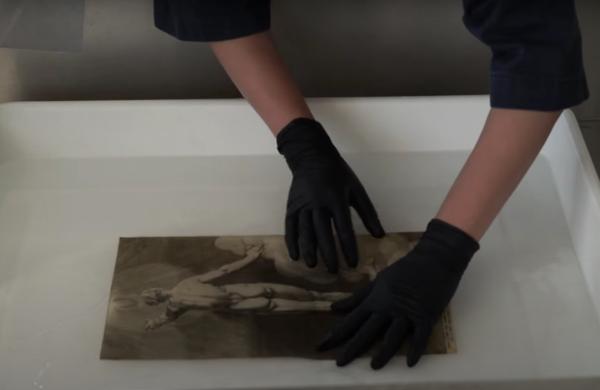This summer, LACMA launched the YouTube series ART + WORK, which shows the care that museum conservators put into preserving a wide range of artworks from our permanent collection.
In this video Paper Conservator Soko Furuhata cleans Jacob Matham's print Diana as Luna (circa 1951) by giving it a full immersion bath.
Below Soko elaborates on this process and discusses how common water-based treatments are in paper conservation.
Tell me a little about the treatment of this print.
The print is pretty discolored so we have decided to surface clean and wash. This discoloration is either inherent to the print or could come from outside sources. In this case, the print is slightly discolored probably because of the degradation of the products within the paper. This happens when there are acidic components in the environment.
Before selecting a treatment, a conservator will actually test the medium on the paper to test its stability. In this case, it has been tested and the ink on the print is stable, so we have decided to fully immerse the paper in a chemically treated solution.
How do you prepare the print for bathing?
In order to prepare for washing, it is essential that the print gets gently humidified so that the intake of the water is even. I spray mist gently from far, but not directly, so that there are no uneven deposits on the artwork.
Once the artwork is in the bath, what are you looking for?
Because this is full immersion water treatment, I need to make sure the print is fully covered in the water. So I am gently pushing the print from one edge to the other to deliver out all the air bubbles. If an air bubble stays, then the print may float on the surface, causing uneven wetting, which may create uneven washing.
Also, there is not a set length of time for washing, but a conservator can determine by looking at the bath to see if it is ready to be taken out. I’m looking for a discoloration product that has leached out from your paper. In this case, it is pretty evident that the color of the water changes yellow.
One thing we don't really want to do is overtreat the artwork. In this case, I wanted to make sure the discoloration and the water staining in the paper was reduced. With one bath, I determined that washing was enough and now I can rinse with deionized water.
Is this a typical treatment used in the paper conservation lab?
People are surprised to know that using water or bathing artwork is a common part of the conservation treatment. We pretest everything to make sure the media is stable enough to withstand such a treatment. Before the treatment starts, I use a bit of water on the ink, and gently blot the section with blotting paper to see if any deposit comes off, but from experience, I know that these types of prints can withstand water treatment.
Also, people may not realize that an actual treatment for a paper conservator can be very fast. It might only take a few hours or even a few minutes, but there is a preparation where you test the medium on the paper to see the best method for treating each artwork. This process of examination could take many hours or even a few days or a few months to come up with the best solution.



